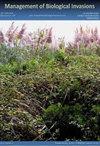在评估当前和未来气候条件下的风险时,使用wra型筛选工具包生成的分数对非本土物种进行排名,哪个校准阈值是合适的?
IF 1.2
4区 环境科学与生态学
Q3 BIODIVERSITY CONSERVATION
引用次数: 5
摘要
基于评分的决策支持工具越来越多地用于识别潜在入侵的非本土物种,作为非本土物种风险分析的风险筛选(初始风险识别)部分的一部分。这些工具包括杂草风险评估(WRA)及其衍生工具,例如水生物种入侵性筛查试剂盒(AS-ISK),已广泛用于世界各地各种陆生和水生植物和水生动物。本文对先前使用两个单独阈值对物种进行风险排序的指南进行了修正,即一个用于当前气候条件(基本风险评估:BRA阈值),一个用于未来气候条件(BRA +气候变化评估:BRA+CCA阈值)。对这一做法的重新评估表明,为了避免物种的不正确风险排名,在wra类型工具包的所有未来应用中,只应该使用BRA阈值,其中包括一组单独的气候变化问题-目前,这涉及AS-ISK和新发布的陆源动物物种入侵筛选工具包(TAS-ISK)。修订后的指南对迄今为止发表的所有包含As - isk应用的研究进行了审查,并对使用BRA+CCA阈值进行风险排序的物种提供了适当的校正风险等级。在审查的AS-ISK应用程序中,只要适用于基于BRA阈值的已发布错误或不正确的风险等级,也会进行更正。本文章由计算机程序翻译,如有差异,请以英文原文为准。
Which calibrated threshold is appropriate for ranking non-native species using scores generated by WRA-type screening toolkits that assess risks under both current and future climate conditions?
Score-based decision-support tools are increasingly used to identify potentially invasive non-native species as part of the risk screening (initial risk identification) component of non-native species risk analysis. Amongst these tools are the Weed Risk Assessment (WRA) and its derivatives, e.g. the Aquatic Species Invasiveness Screening Kit (AS-ISK), which have been extensively used on a large variety of terrestrial and aquatic plants and of aquatic animals worldwide. In this paper, a correction is made to the previous guidance on the use of two separate thresholds to risk-rank species, i.e. one for current climate conditions (basic risk assessment: BRA threshold) and one for future climate conditions (BRA + climate change assessment: BRA+CCA threshold). Re-evaluation of this practice reveals that, to avoid the incorrect risk-ranking of species, only the BRA threshold should be used in all future applications of WRA-type toolkits that include a separate set of climate-change questions – at present, this involves the AS-ISK and the newly released Terrestrial Animal Species Invasiveness Screening Kit (TAS-ISK). As a result of this revised guidance, all published studies containing AS-ISK applications to date are reviewed here, and where approrpiate corrected risk ranks are provided for species that were risk-ranked using a BRA+CCA threshold. Corrections are also made whenever applicable to published errors or incorrect risk ranks based on the BRA threshold in the AS-ISK applications reviewed.
求助全文
通过发布文献求助,成功后即可免费获取论文全文。
去求助
来源期刊

Management of Biological Invasions
Agricultural and Biological Sciences-Ecology, Evolution, Behavior and Systematics
CiteScore
3.40
自引率
6.70%
发文量
21
审稿时长
16 weeks
期刊介绍:
Management of Biological Invasions, established in 2010 by Dr. Elias Dana, is an open access, peer-reviewed international journal focusing on applied research in biological invasions in aquatic and terrestrial ecosystems from around the world. This journal is devoted to bridging the gap between scientific research and the use of science in decision-making, regulation and management in the area of invasive species introduction and biodiversity conservation.
Managing biological invasions is a crisis science, with Management of Biological Invasions aiming to provide insights to the issues, to document new forms of detection, measurements and analysis, and to document tangible solutions to this problem.
In addition to original research on applied issues, Management of Biological Invasions publishes technical reports on new management technologies of invasive species and also the proceedings of relevant international meetings. As a platform to encourage informed discussion on matters of national and international importance, we publish viewpoint papers that highlight emerging issues, showcase initiatives, and present opinions of leading researchers.
 求助内容:
求助内容: 应助结果提醒方式:
应助结果提醒方式:


